In today’s economy, leaders require data surrounding inventory, sales, marketing, production, and supply chain more frequently to help drive business decisions that eventually translate to the bottom line. Much of this data is also required for the month-end financial close process in NetSuite, yet accounting teams often struggle with the requirement to close the books faster. Of 2,300 surveyed organizations, the median organizations reported that their financial close time is at least 6.4 days. It was also reported that reducing this time was their top priority. By doing that, they can free up time to focus on more strategic company priorities rather than mundane tasks.
Most finance teams would agree that there are roughly eight core steps in a good close. These steps include identifying transactions, recording transactions in a journal, posting to the general ledger, preparing an unadjusted trial balance, reconciling debits and credit, creating adjusting journal entries, running an adjusted trial balance and financial statements, and closing the books to reset income statement accounts to zero and lock in balance sheet accounts as of the period’s end. In companies with multiple subsidiaries, the financial close also includes consolidating the division’s financial statements, analyzing intercompany eliminations, and other post-closing adjustments.
NetSuite’s Month-End Checklist gives you a head start on organizing your month-end close processes with guided steps, but it may be somewhat surprising that many companies do not have a formal, documented process for their month-end close. Here at Celigo, the accounting team does have a formal documented process and they also leverage CloudExtend’s NetSuite and Excel integration app ExtendInsights to speed up their month-end close. By using ExtendInsights along with this checklist and continual accounting methods, data is up to date and teams get more time back in their day.
Editing and Uploading Journal Entries to NetSuite
During month-end, it’s often necessary to make edits to existing journal entries, as well as other transactions. A significant amount of time can be saved by editing these transactions in Excel and uploading the changes to NetSuite. For example, if a user created a journal entry and forgot to include the class, especially if the journal entry was over 200 lines, editing line by line would take a significant amount of time and be very tedious in the UI.
With ExtendInsights, a journal entry can be pulled into an ExtendInsights template directly in Excel (no copy/paste required). ExtendInsights can then be used to search for valid NetSuite values for each column. This automates updating every single line of the journal entry at once with a valid NetSuite value and removes manual, line-by-line data entry, making users’ jobs much faster and easier.
Finally, within seconds this data can be upserted back to NetSuite with real-time data validation via standard upsert or burst mode for large journal entries with up to 10,000 rows. So, users no longer have to worry about bad data being added to NetSuite.
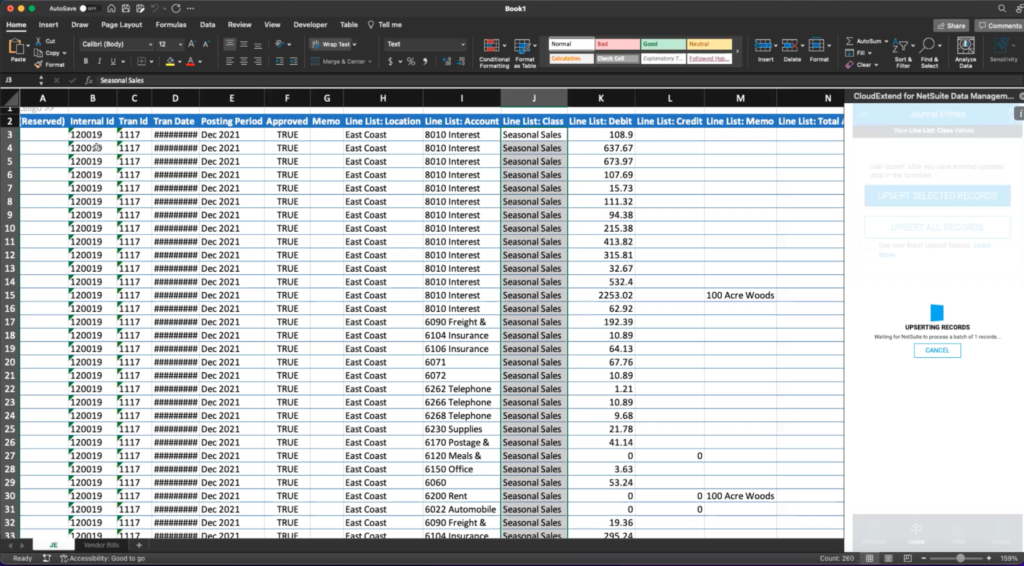
Uploading Vendor Bills to NetSuite at Month-End
During crunch time at the end of the month, accounts payable transactions need to get entered on time. Rather than entering them one by one in NetSuite, they can be bulk uploaded using ExtendInsights. Starting with a list of vendor bills on a template in Excel, ExtendInsights allows the uploading of large amounts of bills all at once.
ExtendInsights will also let the user know if there is a problem with the data prior to upload by highlighting it in yellow.
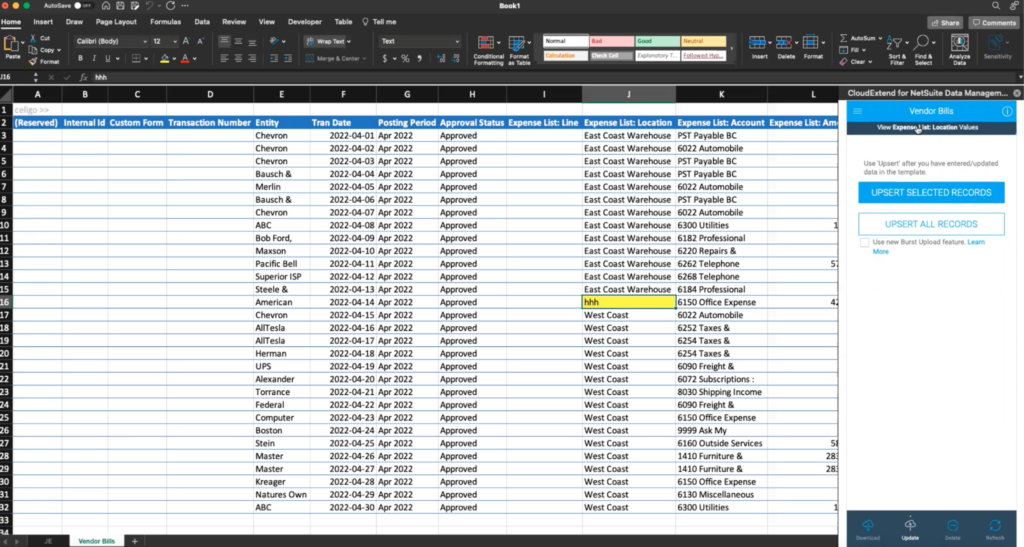
This real-time error resolution allows the user to choose the right field in advance, prior to the upload, improving data accuracy and integrity. Even if the user chooses to upload anyway, despite the error, once that action takes place, ExtendInsights will return a failure message right in Excel so that the data can be fixed on the fly, a big improvement over repetitive CSV uploads.
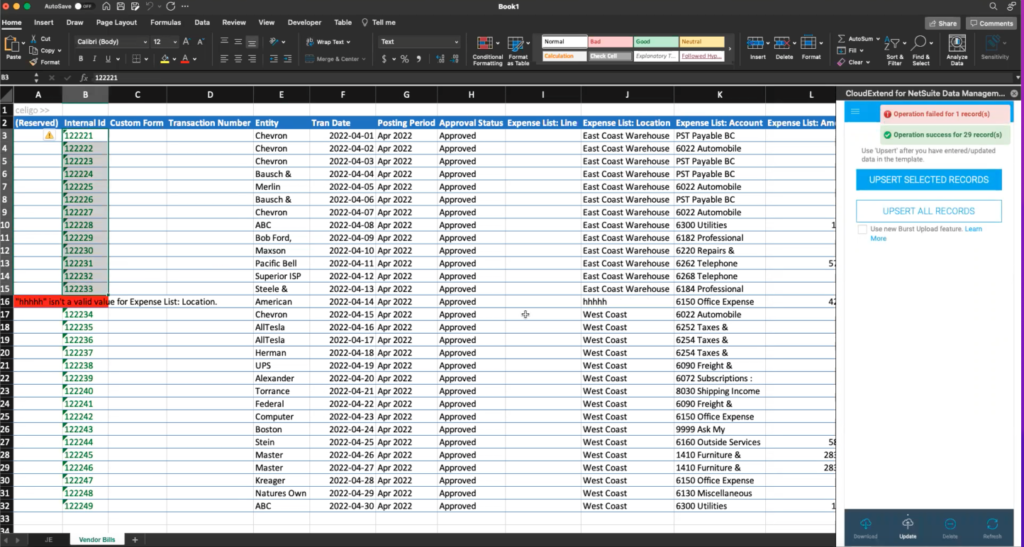
NetSuite Inventory Adjustments at Month-End Close
For organizations that have physical goods within their stores or warehouse, it is a standard practice to update inventory counts on a regular basis. Once regular inventory counts are established, inventory adjustments sometimes need to be created. Inventory adjustments will display and update what is on hand in the stores or warehouses within an organization’s NetSuite environment. Then, the Inventory Adjustment transaction in NetSuite is used to push any inventory variance to NetSuite.
When stores or warehouses do their physical count, they need to capture this data somewhere. Typically they would capture it in an Excel workbook. The benefit of having it within Excel is that it’s an environment that finance users are very familiar with and it makes modifications much more straightforward, but manual data entry can still be problematic.
That’s where ExtendInsights comes in. ExtendInsights can be leveraged to create a template for conducting an inventory adjustment for hundreds of these items simultaneously in a fraction of the time it would take to do it manually inside of NetSuite. Once created, the template can be used over and over. This is another way to optimize tedious tasks required for month, quarter, and year-end.
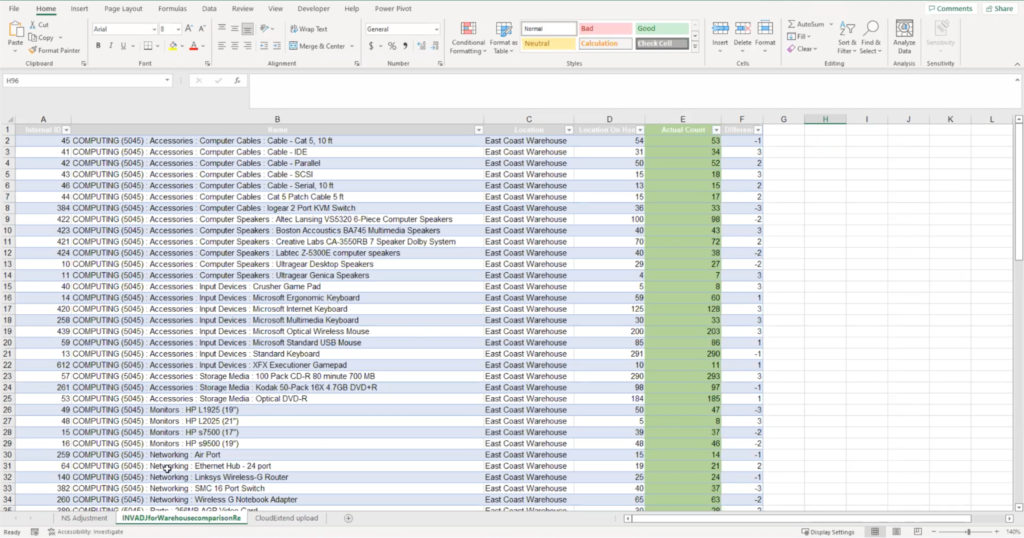
Uploading Credit Card Statement Transactions to NetSuite at Month-End
When the month-end close process in NetSuite is long, eliminating time-consuming tasks like entering credit card transactions one by one, is critical. Using Excel and ExtendInsights, a reusable template can be created to turn this into a repeatable process that can be done in a minute to three minutes on a monthly basis or with continual accounting, can be done even more often than that.
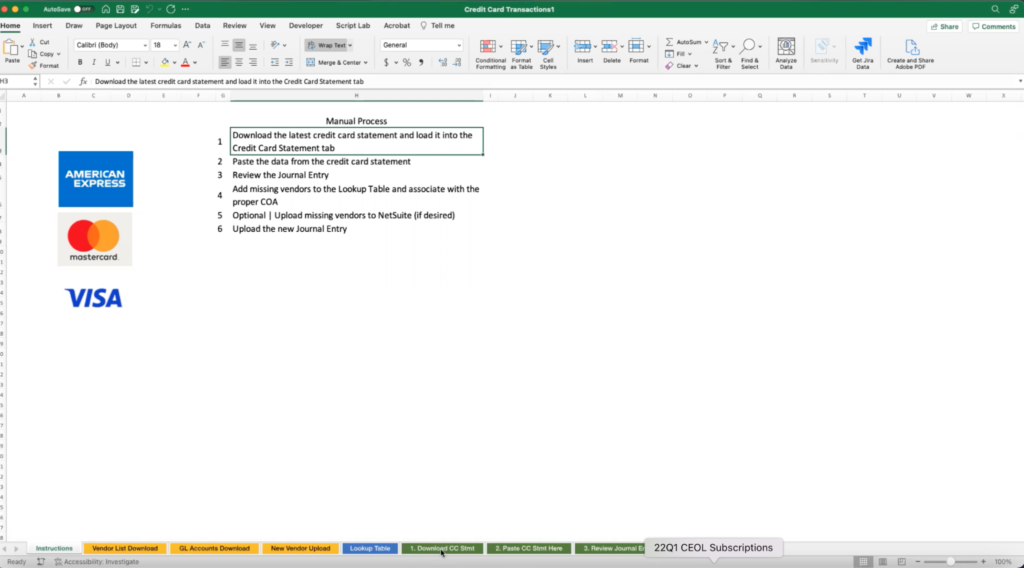
It starts with downloading the credit card statement and pasting it into the ExtendInsights journal entry template. This simple process produces a ready-to-upload journal entry. Once ExtendInsights is opened, by clicking ‘upsert record,’ in just a few seconds this information can be added to NetSuite. Adding new vendors or entities from the credit card statement and editing (or deleting with proper permissions) existing journal entries can also be automated, making what once could take hundreds of hours, require only a fraction of the time depending on the volume of transactions.
A Faster Month-End Close Process
You’ll often hear that spreadsheets are antiquated and become out of date quickly. Because of this, we highly recommend using NetSuite as your single source of truth. But you will still need a faster and more efficient way to get your data into NetSuite and that’s where ExtendInsights really shines.
ExtendInsights provides the best of both worlds, the speed, power, and flexibility of Excel along with the tools to get your data in NetSuite quickly. Our customers, such as Nanit, Brandy Melville Australia, and SalesLoft, have reduced their close time by three or more days. By using ExtendInsights along with continual accounting methods your data will be up to date and your team will get back time in their day. Try it here.
